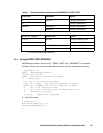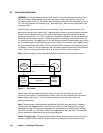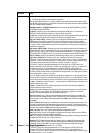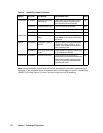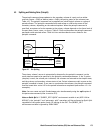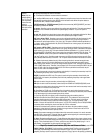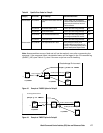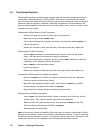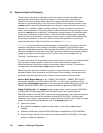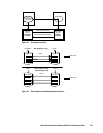
Hitachi Command Control Interface (CCI) User and Reference Guide 175
Options
Note: Only one
pairsplit option (-r,
-rw, -S, -R, or -P)
can be specified.
If more than one
option is
specified, only the
last option will be
executed.
-h: Displays Help/Usage and version information.
-q: Terminates the interactive mode and exits this command.
-z or -zx (OpenVMS cannot use the -zx option): Makes the pairsplit command enter the interactive mode.
The -zx option guards performing of the HORCM in the interactive mode. When this option detects a
HORCM shut down, interactive mode terminates.
-I[H][M][instance#] or -I[TC][SI][instance#] Specifies the command as [HORC]/[HOMRCF], and used
for specifying instance# of HORCM.
-g <group>: Specifies a group name defined in the configuration definition file. This option must always
be specified. The command is executed for the specified group unless the -d <pair Vol> option is
specified.
-d <pair Vol>: Specifies the paired logical volume name defined in the configuration definition file. When
this option is specified, the command is executed for the specified paired logical volumes.
-d[g] <raw_device> [MU#]: Searches a group on the configuration definition file (local instance) for the
specified raw_device, and if the specified raw_device is contained in the group, the target volume is
executed as the paired logical volume (-d) or group (-dg). This option is effective without specification of
“-g <group>“ option. If the specified the raw_device is contained in two or more groups, the command is
executed on the first group.
-d[g] <seq#> <LDEV#> [MU#]: Searches a group on the configuration definition file (local instance) for
the specified LDEV, and if the specified LDEV is in the group, the target volume is executed as the paired
logical volume (-d) or group (-dg). This option is effective without specification of “-g <group>“ option. If
the specified LDEV is contained in two or more groups, the command is executed on the first group. The
<seq #> <LDEV #> values can be specified in hexadecimal (by addition of “0x “) or decimal notation.
-r or -rw (TrueCopy only): Specifies a mode of access to the SVOL after paired volumes are split. The -r
option (default) allows read-only to the SVOL. The -rw option enables read and write access to the SVOL.
-S: Selects simplex mode (deletes the pair). When the pairing direction is reversed among the hosts
(e.g., disaster recovery), this mode is established once, and then the paircreate command is issued.
When splitting a pair, whether or not you can change the pair status of S-VOL, changing the pair status of
P-VOL to SMPL takes priority. Therefore, if the pair status of S-VOL cannot be changed to SMPL, the pair
status of P-VOL might not correspond with that of S-VOL. When a path failure has occurred, the pair
status of S-VOL cannot be changed to SMPL.
-R: Brings the secondary volume into the simplex mode forcibly. It is issued by the secondary host, if the
host possessing the primary volume is down or has failed.
-R[S][B] (Specifiable for HORC only): This option is used to bring the secondary volume forcibly into
simplex mode. It is issued by the secondary host if the host possessing the primary volume goes down
due to a failure.
-RS option is used to bring the secondary volume forcibly into SSWS mode.
-RB option is used to back the secondary volume forcibly from SSWS into PSUS(PSUE)(SSUS) mode.
This makes to be able to back to the primary volume if the user wants to back from the secondary host in
SSWS state on Link failure to the primary host.
-P (Specifiable for TC/UR only): For TrueCopy Sync, this option is used to bring the primary volume
forcibly into write disabled mode like PSUE with "fence=data". It is issued by the secondary host to disable
PVOL data changes by the host possessing the primary volume.
For TrueCopy Async/JNL, this option is used to suspend and purge the remaining data into
SideFile/Journal like link failure (PSUE) without updating SVOL. This enables the user to stop journal
operations forcibly when the journal utilization traffic becomes high. This is the same for the case of
disaster that S-vol data is not up to date, but it allows to specify “-rw –P” for writing enable. In that
situation, if the user will use the SVOL as file system (i.e. UFS, NTFS, HANFS), then an FSCK(CHKDSK)
is necessary before mounting the volume even after the PVOL is unmounted.
-l: When this command cannot utilize the remote host for host down, this option enables a pairsplit
operation by a local host only. Except the -R option, the target volume of a local host must be P-VOL.
(ShadowImage volumes are able to split only SVOL.)
-nomsg
: S
uppresses messages to be displayed when this command is executed. It is used to execute a
command from a user program. This option must be specified at the beginning of a command argument.
The command execution log is not affected by this option.
-C <size> (ShadowImage/Snapshot only): Copies difference data retained in the primary volume into the
secondary volume, then enables reading and writing from/to the secondary volume after completion of the
copying. (This is the default option.) For <size>, specify the copy pace for the pairsplit (range = 1 to 15
track extents). If not specified, the value used for paircreate is used.
-E (ShadowImage only): Suspends a paired volume forcibly when a failure occurs. Not normally used.
-FHORC [MU#] or -FCA [MU#]: Forcibly specifies a cascading Hitachi TrueCopy volume for specified
volume pair on ShadowImage environment (see example in Figure 4.3). If the -l
option is specified, a
cascading TrueCopy volume is split on a local host (near site). If the -l option is not specified, a cascading
T C l i lit t h t (f it ) Th t t HORC l t b P
VOL



